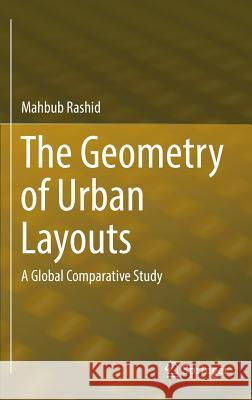The Geometry of Urban Layouts: A Global Comparative Study » książka



The Geometry of Urban Layouts: A Global Comparative Study
ISBN-13: 9783319307480 / Angielski / Twarda / 2016 / 453 str.
The Geometry of Urban Layouts: A Global Comparative Study
ISBN-13: 9783319307480 / Angielski / Twarda / 2016 / 453 str.
(netto: 383,36 VAT: 5%)
Najniższa cena z 30 dni: 385,52
ok. 22 dni roboczych
Dostawa w 2026 r.
Darmowa dostawa!
This book presents a compendium of the urban layout maps of 2-mile square downtown areas of more than one hundred cities in developed and developing countries-all drawn at the same scale using high-resolution satellite images of Google Maps.
Dedication.- Acknowledgement.- Part I.- The Geometry of Urban Layouts: A comparative study of the urban layout maps of downtown areas in cities around the world.- Introduction.- What is this book about?.- Why do we need this book?.- How is this book going to affect urban design and science?.- An overview of this book.- References.- Urban layout and its significance.- Introduction.- Geometry, spatial representation, and urban layout.- Urban layout as map space.- The significance of urban layout.- References.- Studies on the geometry of urban layouts: A review of the literature.- Introduction.- Metric geometric studies of urban layouts.- Normative aesthetic studies of urban layouts.- Empirical studies of urban layouts.- Morphological studies of urban layouts.- Configurational studies of urban layouts.- Fractal studies of urban layouts.- “Space syntax” studies of urban layouts.- GIS in configurational studies of urban layouts.- Discussion and conclusions.- References.- Materials and measures.- Introduction.- Study sample.- Study area.- Urban layout maps.- Street maps.- Urban block maps.- Linear maps.- Preparing the maps.- Urban layout measures.- Measures: Street and street centerline maps.- Measures: Urban block maps.- Measures: Axial and segment maps.- References.- Detecting ordinaries, extremes, similarities, and differences: Univariate descriptions of urban layouts .- Introduction.- Univariate descriptions of street and street centerline maps.- Univariate descriptions of urban block maps.- Univariate descriptions of axial and segment maps.- Extremes, similarities, and differences in the geometry of urban layouts .- Exceptional cities around the world.- Exceptional cities in developed countries.- Exceptional cities in developing countries.- Differences and similarities in urban layouts of cities in developed and developing countries.- Discussion and conclusions.- Examining scaling laws: Bivariate descriptions of urban layouts.- Introduction.- Scaling laws.- Mathematical expressions.- Scaling in biology.- Scaling in cities.- Rank-size distributions in the geometry of urban layouts.- Rank-size distributions in street and street centerline maps.- Rank-size distributions in urban block maps.- Rank-size distributions in axial and segment maps.- Discussion: Rank-size distributions in the geometry of urban layouts.- Allometry in the geometry of urban layouts.- Allometry in street and street centerline maps.- Allometry in urban block maps.- Allometry in axial and segment maps.- Other allometric relations between the measures of different urban layouts.- Discussion: Allometry in the geometry of urban layouts.- Discussion and conclusions.- References.- Developing descriptive categories, types, and indicators: Multivariate descriptions of urban layouts.- Introduction.- Criteria for descriptive categories of the geometry of urban layouts.- Descriptive categories of the geometry of urban layouts and their types and measures.- Quantity.- Density.- Granularity.- Compactness.- Continuity.- Accessibility.- Complexity.- Descriptive indicators, and similarities and differences in the geometry of urban layouts.- Quantity indicators.- Density indicators.- Granularity indicators.- Compactness indicators.- Continuity indicators.- Accessibility indicators.- Complexity indicators.- Discussions and conclusions.- References.- Robustness, resiliency, and universality in the geometry of urban layouts.- Introduction.- Urbanity and the physical environment of the city.- The physical environment of the city and the descriptive system of the book.- Contributions of the book.- Univariate analyses.- Bivariate analyses.- Multivariate analyses.- Moving forward.- Postscript.- References.- Part II.- The Geometry of Urban Layouts: A compendium of the urban layout maps of downtown areas in cities around the world.
Mahbub Rashid is a Professor of the School of Architecture, Design, and Urban Planning at the University of Kanas. Presently, he serves as the Associate Dean for Research and Graduate Studies of the school, and the Chair of the MA/PhD Programs in Architecture. With a Master’s degree from MIT and a PhD degree from Georgia Tech, Dr. Rashid is an expert in theories and methods of architectural research with a focus on the structures of form and space. He uses innovative spatial and social network, fractal, and statistical analysis techniques along with more traditional research methods and methodologies to study the effects of built form and space on human behavior, psychology, society and culture in office, healthcare, and urban environments. Registered as an architect in Georgia, USA, Dr. Rashid also works as an architectural consultant for reputable architectural design firms. Dr. Rashid has over 80 major and minor publications. His major publications include over 50 peer-reviewed articles (about 40 of them as the sole and/or main author) in journals, books, and conference proceedings.
This book presents a compendium of the urban layout maps of 2-mile square downtown areas of more than one hundred cities in developed and developing countries—all drawn at the same scale using high-resolution satellite images of Google Maps. The book also presents analytic studies using metric geometrical, topological (or network), and fractal measures of these maps. These analytic studies identify ordinaries, extremes, similarities, and differences in these maps; investigate the scaling properties of these maps; and develop precise descriptive categories, types and indicators for multidimensional comparative studies of these maps. The findings of these studies indicate that many geometric relations of the urban layouts of downtown areas follow regular patterns; that despite social, economic, and cultural differences among cities, the geometric measures of downtown areas in cities of developed and developing countries do not show significant differences; and that the geometric possibilities of urban layouts are vastly greater than those that have been realized so far in our cities.
1997-2025 DolnySlask.com Agencja Internetowa
KrainaKsiazek.PL - Księgarnia Internetowa









